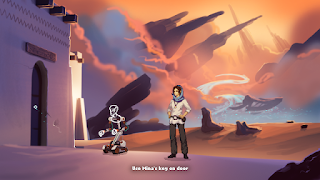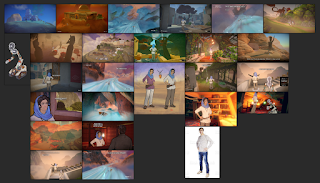I've had a few different people ask me about my process for using 3D and for painting low resolution scenes, lately, so I've been sharing a basic step by step of this recent tribute to Heaven's Vault that I drew. I'm posting it here so that I can link people to it whenever they ask.
Step one is to gather reference files. Especially important because I'm paying homage to someone else's vision, and I want to try to be reasonably accurate. I have a mix of screenshots, concept art, pose references, anything that I think might be important. I use PureRef for handling my reference images, a wonderful free tool that I recommend to everybody working with reference material.
Following my reference, I make a very basic 3D model that allows me to experiment with composition. I vaguely know in my head what lighting setup I'm going to use, so I put that in place as well. My goal at this point is to get my 3D models fairly accurate to the source. With an accurate model I can easily change positions of things with relation to the camera, so getting that right makes life much easier when I want to move things. I render this with a transparent background, because I know I'm going to paint my own sky in. I'm using Blender here - a great, free tool that does everything I need.

For the characters, I use Aseprite, a program that I've been using for pixel work for years. I like to have a basic sky colour in here, so I can see how everything looks together, and for pixel characters I don't really have any secrets. Just work to the reference, try to be accurate, and try to capture their character in the basic standing pose. Aliya and Six are nice to do because they're quite distinct, which usually feels like I know when I haven't quite got them right and need to keep working on them. Most of the challenge is just in fighting the pixels, and getting the look right in such low levels of fidelity.

With the characters just about right, I block in my sky and backdrop. Getting this in place sets me up to decide the composition of the rest of the foreground elements that I know I need to have. There's no secret to this, really, just working from my reference images, and trying to make nice silhouettes that interact with each other in interesting ways. For example, I know I wanted to have two of the long stone spires cross each other in an interesting way, and I know I wanted to have the river dip behind the cloud before re-appearing.
With the distant composition mostly solved, I paint in the foreground elements that I know I need to have. In this case, the only essential element was the feet of a broken off statue present in this location. I block these in roughly, and try to rough out how the light is going to affect them and how they'll affect the light on the ground that they sit on.

With all of my essential elements in place, it's time to finalize the composition. This is an extra step for a mockup that I'd never do in a painting for a game, because there's no way of knowing where a character is going to be in a game. Here, though, I know Six is going to be harder to read against a light backdrop because of his white features, so I put a nice dark lump of stone behind him. I know Aliya's outfit has a warm beige for her torso and a cool blue for her headscarf, so I paint the backdrop cool to contrast against her torso and warm to contrast against her head. I also add in some framing elements like the rock in the bottom right, and try to push the lighting on the flat surfaces a little.

From this point on, it's just careful painting work, tweaking colour values, adjusting things for balance, and constantly checking my reference when adding detail to things like the ship and the buildings. Very few secrets here, just painting to the best of my ability and patience. Eventually I reach a point where I'm tired of painting detail, and any further painting is just fiddling, and I call the piece done. I then like to wait a couple of days, just to catch any stupid mistakes that I made because I was tired of working on the piece and rushing to get finished, and then it's finished for real. As soon as I show it to everybody, I notice all the mistakes, and vow to learn from these for next time.







